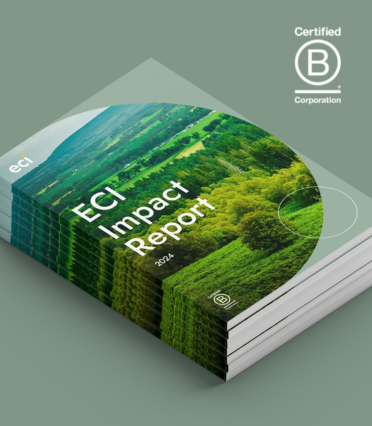ECI recently moved out of its old office at Brettenham House after 37 years. When we were looking at new office design, one of the key drivers was that we wanted to ensure we could move as sustainably as possible. But that is really difficult! Questions emerge around what to do with 37 years of stuff, the need to balance green ambitions with the pragmatism of finding the right office and ensuring you can create a modern new office without items having a high carbon footprint. These add a layer of complexity to what is already a big project. Here we’ve pulled together our top tips for moving office sustainably and some of the work done by the ECI team:
1. Creating an energy efficient office
- In an ideal world, you would always select the most efficient office and minimal work would be required to improve performance. But realistically, there are other drivers for selecting an office, and for ECI a big one was location. The team have planned their lives around commuting to the ECI office, so we wanted to ensure the move was also minimally disruptive to that. And in midtown, where we were already based, there aren’t many modern new builds, so we knew the choice were more likely to be older buildings refurbed and refitted.
- And while these may not be as efficient in the day to day running, it is usually less carbon intensive to refit and renovate buildings rather than demolish and build. A good example of this is the current row over Marks and Spencer’s flagship store on Oxford Street – demolishing it would likely release 40,000 tonnes of embodied carbon, the equivalent of almost 20,000 flights from London to Sydney.
- That meant we had to look at refurbed buildings and assess the energy efficiency, but also the potential. What could be done in our own floorspace and the wider building over time? So, when we found 80 Strand, we initiated a project with the landlord to introduce secondary glazing to our floor and are working with them long-term to deliver on energy efficiency initiatives. We made sure that ECI was on a renewable contract and are working to look at smart meter options. We also managed what we could control, ensuring the underlying engineering aligned with best practice standards by installing motion sensors for the new energy efficient LED lighting with different timers dependent on location to maximise efficiency. So, for example, open plan lighting turns off quickly when areas aren’t in use, but corridor routes stay on for longer.
Tip: Perfection and pragmatism won’t always align when it comes to finding a new office. Work out what is key to your business, take into account the potential improvements you can make and get started on them early!
2. Sourcing products
We worked closely with our design agency Peldon Rose to source products locally and from renewable materials where possible. This included:
- Carbon neutral acoustic panels made from 100% polyester fibre (PET), at least 60% of which is recycled material, and sourced from a zero-waste manufacturing initiative.
- Carpets made from ECONYL, 100% recycled nylon which is exactly the same as brand new nylon and can be recycled, recreated and remoulded again and again. Including the backing, the carpet is made from 69% recycled total content, and is cradle to gate carbon neutral with offsetting
- A British manufactured kitchen sourced sustainably from FSC (Forest Stewardship Council) managed sources.
- The majority of the new furniture has been sourced from British designers and manufacturers, from sustainable practicing manufacturing facilities powered by 100% renewable electricity. These facilities bring quality employment opportunities to areas such as Lincolnshire, Somerset and South Wales, adding social and economic sustainable aspects. This furniture was supplemented with a few select pieces sourced from Denmark, a leading country in sustainable manufacturing.
Tip: When working with a partner highlight the importance of sustainability early and keep asking questions throughout the moving office process. Don’t get dazzled by beautiful design, find out what it’s made of, where it was made and what the end of life might look like. The furniture industry in particular is incredibly focussed on sustainability right now, so if one product doesn’t work, another one probably will.
3. Reuse
- We knew that we wanted to absolutely minimise our waste to landfill from our existing site but also that a key part of the office move would be everyone being excited by a new look and feel.
- To achieve both these objectives we completed a full office reusability assessment, with every item being considered as to whether it was something that could potentially be moved across to the new office. We were surprised that actually, as long as we designed around them, some of the most significant pieces of furniture such as office chairs, boardroom tables and meeting room chairs, could be kept as part of the move.
- We partnered with charity Waste to Wonder for the items we could not reuse, with all 86 items that we donated, from desks to chairs, repurposed for education facilities in Cameroon.
48
% of furniture items in new office are repurposed
100
% of unused furniture was reused by charity
Tip: It’s easy to come to dislike office furniture you see every day, but make sure you are fully considering whether it might work (with a clean/refurb) in the move. Often these are high quality items that still function perfectly well.
4. Resell
- Once we had worked out which items we could move over, that still left several items for us to find a home for. We decided the first port of call would be an ECI charity auction, giving people the option to bid on items from the office – from lamps to artwork – raising crucial funds for our charity partner, The Bread and Butter Thing. It also gave people an opportunity to donate gifts or promises to support our fundraising efforts.
- Overall, we sold 62 items and raised c.£10,000 for our charity partner. And importantly, it was a large batch of items that wouldn’t be going into landfill.
Tip: You would be surprised by what people secretly have their eye on in your existing office! Not only does this create a unique fundraising opportunity, but it also builds buy-in for the sustainable office initiative.
5. Recycle
Following an IT audit to understand which tech needed upgrading to improve efficiency, we knew we wanted to ensure our old technology – from computers to random charging cables – was removed sustainably. We partnered with two charities to ensure that it could be reused/recycled as appropriate. These were:
- We partnered with Computeraid, a leading registered charity for providing refurbished IT equipment. This meant old monitors, PCs and laptops were cleaned and then donated to non-profits like schools, charities, or community centres throughout the world, ensuring it does not end up in landfill. Even items like wires and charging cables are stripped for parts so that the underlying components can be recycled.
- Further equipment was donated to CPR Computer Recycling where the items are sold and all profits are given to charity.
100
% of waste from build diverted from landfill
Tip: It is absolutely possible to pursue a zero waste to landfill strategy as part of moving office sustainably. Whether you’re looking to reuse or recycle, find the right partner and make sure it is included as a line item in your budget from the start.
6. Green office policies
- Moving office is a fantastic opportunity to trigger behavioural change within your team. Now is the time to think about what the greenest version of your office looks like and what behaviours do you need from your team to support that? At ECI we created a wishlist of everything we’d like, and then prioritised what we thought we could change immediately and what we might need to develop longer term.
- This included really committing to going paperless. That meant stopping business cards as standard, implementing a clean desk policy and minimising printers throughout the office to support that transition.
- At ECI we removed bins from people’s desks and set up proper recycling hubs throughout the office instead. We now recycle our espresso pods and are looking at options for terracycle in the future.
- As well as automatically turning off as much as possible through sensors, teams are encouraged to turn off everything at the end of the day, and this is tracked to see adherence. Not only does this reduce energy use, it also is key for ensuring IT systems are being updated and reduces cyber risk.
Tip: Make a wishlist of everything you could potentially do in the office and then prioritise by impact and ease of implementation.





